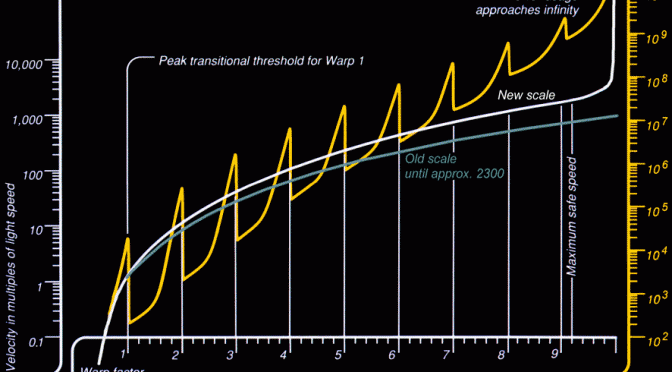For the long time readers of this blog it shouldn’t come as any surprise that I’ve been watching Star Trek since I was a child and to this day still watch the reruns. In fact, in the last couple of years I’ve been watching the H&I “All Star Trek” block every day. As a result, though I don’t actually pay attention to every episode (I’ve seen all of them several times before), reruns of Star Trek have been running as the background track to my daily activities for quite a while. It’s habit, mostly, and every once in a while I’ll look up from whatever I’m doing to either watch one of my old favorites or come to recognize some of the flaws that I overlooked as a kid. The franchise taught me a lot about speculative fiction, for better or worse, and to this day I appreciate it for what it is – flaws and all.
One of the flaws that Trekkies debate constantly is just how consistent some aspects of the world actually are. Continuity is a big deal to the average nerd, and continuity tends to get stepped over often for the sake of an individual episode’s plot. As I’ve said in the past, while the little details may not necessarily matter to the plot, they’ll usually matter a lot more to your audience than you expect them to. And one of the greatest inconsistencies in Star Trek over the decades lies in the distances they travel and how fast they actually do it. Everyone is familiar with the idea of “Warp Speed” and has an understanding that it’s faster than light, but only Trekkies are aware that there are times when Warp Speed is sometimes less about the speed of light and more about the speed of plot.
“Oh god,” I can hear you saying, “a Trekkie is about to complain about numbers, just like mom warned me would happen.”
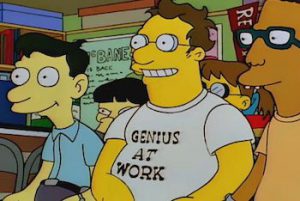
But when I bring this up I don’t bring it up as some jackass with no life who obsesses over the details of fictional worlds. No, I bring this up as a writer with no life who obsesses over the details of fictional worlds. You see, there’s something to be learned not only from the inconsistencies but the reaction those inconsistencies get. It’s been long known that Star Trek’s technobabble can be a barrier for entry for some audiences, but something often overlooked is that there are times when decisions are made, for the sake of technobabble, that actually run counter to their intention.
Because, when you really look at those numbers you realize something: the writers rarely had a clue of what any of them meant – so how could we?
Unbelievably Fast, Deceptively Slow
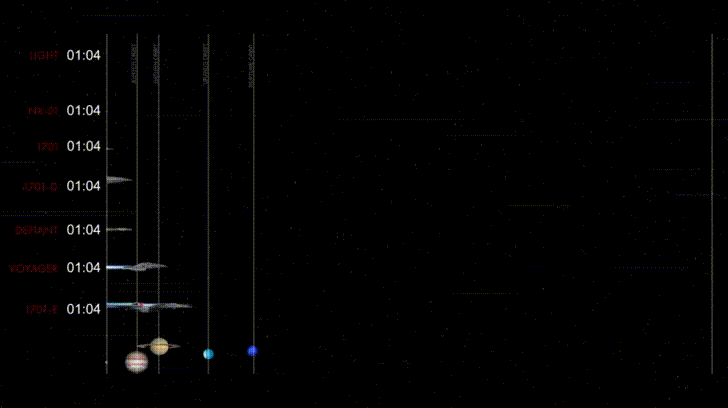
When Gene Roddenberry first came up with the idea of Star Trek, one of the things he established early on was just how fast these ships were supposed to go. His early scale was pretty simple: the speed of a specific “Warp factor” was just the cube of that number – so Warp 2 was 8 times the speed of light while Warp 9 was 729 times the speed of light. It was a straight forward system and… eventually stopped mattering at all. Throughout the original series, the Warp factors tossed out rarely mattered and if anything specific was said they were well off the actual scale. The numbers were just used to make things sound impressive and any time they were going a crazy distance they would pull a new number out of their rear neutral zones. The speed of things encountered just kept climbing in Warp numbers to indicate “really damn fast”, eventually peaking in The Animated Series with a ship that could travel at Warp 36 – a number indicating that ship was to the Enterprise as Usain Bolt is to the majority of humanity.

But Roddenberry came to realize just how trivial the numbers had become and felt that there was no tension to the story because any time the ships needed to go faster there was nothing really stopping them. So he set out to have a more concrete and finite scale put in place, one that would become the standard for any Star Trek set after TOS (anything set before still using the old scale, because the continuity of inconsistency had to be preserved!). The new scale established a few boundaries and worked from there. At Warp 1 you were moving at the speed of light and at Warp 10 you would achieve INFINITE VELOCITY (more on that later). Everything in between would be determined by math, which was a mistake, because the only people who were willing to do the math were apparently the science advisors and they were to be soundly ignored if they ever rained on the parade.

The thing is, once they finally started hammering down the numbers (and, worse, releasing them to their fans) the inconsistencies started to grow. Everything was thought to move at the “speed of plot” whenever things started to grow inconsistent, but the truth was that actually wasn’t the case at all. Time and time again, the creators actually did everything they could to make the ships slower to increase the dramatic tension of their story. Their entire goal was to make everything seem more dramatic by making it harder to get where they needed to go. At one point The Next Generation even devoted an entire episode to “if you use Warp too much, it’ll destroy the universe”.
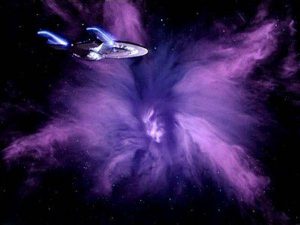
Yet something stood out to me about the inconsistencies long ago. Though I never really cared and was perfectly fine with the ships moving at the speed of plot if it served the story, I spotted something a little funny. Despite the fact the creators continually tried to throttle the speed of the ships to add tension, the fact was that inconsistencies almost always made the ships faster rather than slower. For a while I couldn’t quite figure out why until I came to realize what the numbers were telling me. The fact was the inconsistencies were there because the writers were making one of two mistakes – they were either overestimating the speed of light or underestimating the size of the universe (and, hell, possibly both).
The first clue to this is the fact that most inconsistencies happen when the details aren’t actually important to the plot. If it’s just a short trip that doesn’t seem to matter that much, it will happen at speeds that shatter the scales as the ship ends up going hundreds of thousands times the speed of light. This is especially true if it’s under a light year, because that sounds like it’s just next door in the cosmological scales (because, really, it is). On the other hand, if it’s important to the plot, they nailed that thing down and actually broke out the math to do it.
Star Trek Voyager opens with the conceit that it’s going to take them about 70 years to travel 70,000 light years, which fits pretty close to the scales where Warp 9 equals ~1500 times the speed of light and the ships ostensibly can’t go full speed non-stop. This was an important detail, the very basis of their entire series. On the other hand, when traveling only half a light year, Voyager managed to do it in a couple seconds at Warp 7, which was the equivalent of going about 10,000,000 times the speed of light. For reference, this means that the ship could have gotten back to Earth in two and a half days at “Warp 7”.
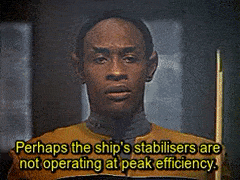
And it’s easy to understand why: like I said before, cosmologically “half a light year” is right next door, so it feels like it’s a quick trip. But in reality, half a light year is still a huge distance. If they used the scale at that moment to actually crunch the numbers, they would have realized that the trip itself would have taken them 8 hours. And I don’t blame them for not being able to figure that out without breaking out the calculator, because the distances are so vast that the human brain has a hard time fathoming it. After 4 decades of traveling faster than almost everything else launched by mankind, at 38,000 miles an hour, the real-life Voyager 1 probe has managed to travel a grand sum total of 0.0019 light years. Meaning that by the time Voyager 1 happens to travel even half a light year, its angry little brother V’Ger will have already come back to try to find its creators.
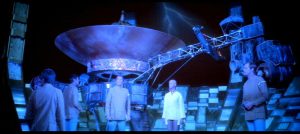
In fact, it was an episode of Voyager airing in that “All Star Trek” block a few days ago that really got me thinking about this lack of scale in the minds of the creators. In an episode called “Threshold”, the crew modify a shuttle to achieve Warp 10, which you’ll remember is INFINITE VELOCITY – essentially existing at all points in the universe at once. They don’t have to build a whole new engine, they don’t have to create this shuttle from scratch, they just have to tweak the engines they already have to use… a new kind of dilithium. And it makes sense if you look at the “Warp factor” and aren’t really thinking about what it really means. Voyager can already travel at “Warp 9.975” which is 5126 times the speed of light (roughly equivalent to the speed of a nerd correcting someone on the internet). And while it’s obvious that 5126 is a lot smaller than infinity, if you just focus on the “Warp factor” it looks like it’s only 0.025 away from 10 – so of course you could resolve that with a better version of this particular rock.

And it’s because of this discrepancy between perception and reality that every time the creators tried to make their ships slower to build tension they ironically made them faster by accident. The prequel series Star Trek: Enterprise was to show the first ship capable of Warp 5 (in the old scale), and the entire series was based around that idea of “we’re the underdogs!” Several episodes over the course of the series were dedicated to the idea that the Enterprise, at only Warp 5, wasn’t quite fast enough to simply outrun danger. And yet, in the very first episodes of the series, the Enterprise is given the task of traveling to the Klingon homeworld which one of the characters say is “4 days away at Warp 4.5”. I’ll give them this, that would have been some really dramatic shit since it would put the Klingon homeworld and their star right about here.
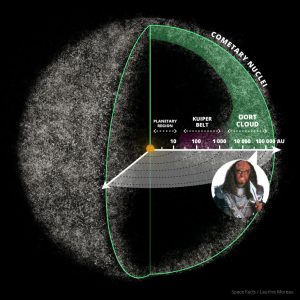
In actuality, given where they usually put “Qo’noS” on star charts, it would have taken the good ship NX-01 a year to make the trip. It’s somewhat understandable, it’s just a quick line thrown out while discussing what is essentially a macguffin in the shape of an angry space warrior that needs a ride home. But this is where the lesson is learned, because a lot of people agree that the first season of Enterprise was among its weakest and that was mostly because the overarching plot holding that season together was…not great. And yet, in their very first episode, had they just done the math, that pissed off macguffin warrior could have become a fantastic plot device.
In the first episode of ST: Enterprise, a Klingon warrior carrying vital intelligence for the empire is found injured and near death on Earth after a run in with a local farmer while fleeing enemies. In an effort to show they can stand on their own two feet, Captain Archer insists that they should be the ones to take this man and the intel he’s got back to his people. The Klingons have been made aware that their operative has been nearly killed on Earth, and the Vulcans are offering to get him home (with a 100 day journey at Warp 7, if anyone did the math), but Archer wants to prove they can do this. Picture if they had realized just how far that distant world actually had to be, how much more tense would that story have been?
That first season could have been dedicated to that mission, to dealing with that Klingon. Every disaster and new race they encountered could have been a hurtle between them and completing that first mission. They could have been intercepted by Romulans, had to carefully navigate the conflicts on the borders between Vulcan and Andorian space, and spent the entire time with a full out Klingon warrior among a crew of explorers. Every encounter would be punctuated with their Vulcan science officer and their Klingon passenger presenting two starkly different views on how this crew should deal with the greater universe. And with every decision made, there would be a chance that humanity could side with the Klingon mentality in an effort to not fail that first mission. And then, after a year of that sort of dynamic, maybe this scene…
Might have actually mattered.
(I write novels and dabble in screenplays. To be fair to Enterprise, I was one of the people who actually liked it, but I can see why it struggled to pick up viewers. If you disagree, let me know on twitter.)


